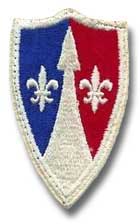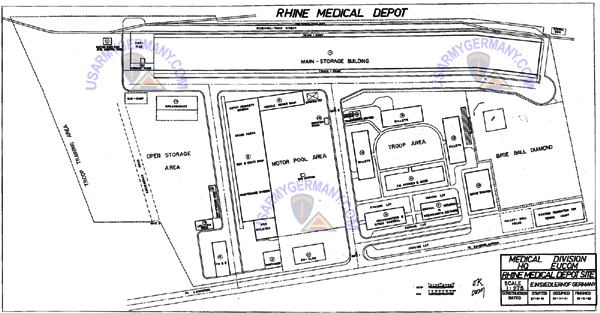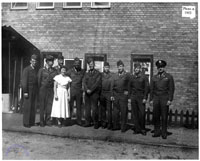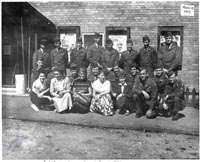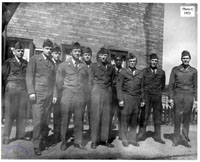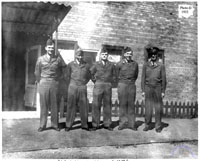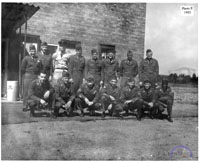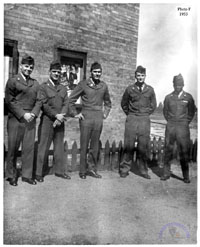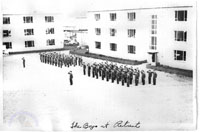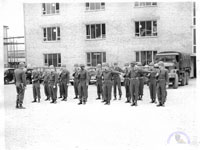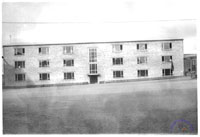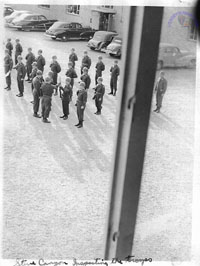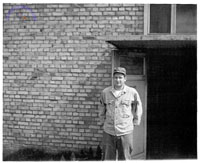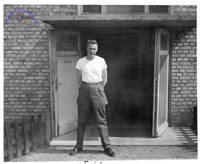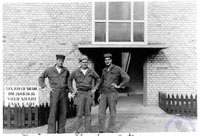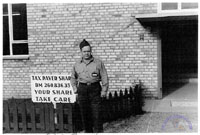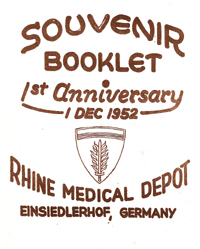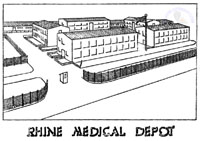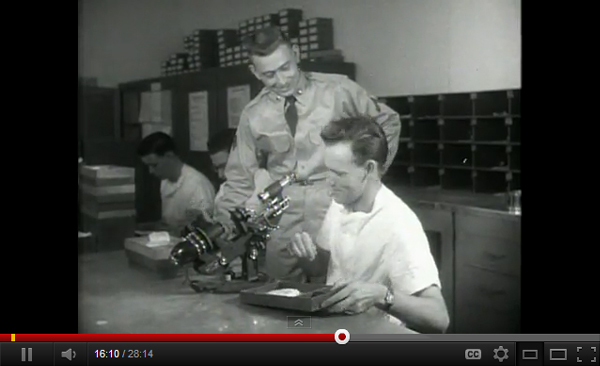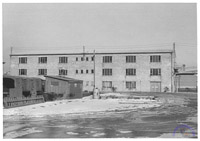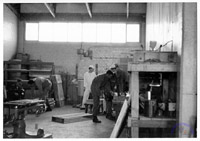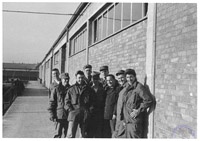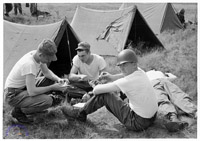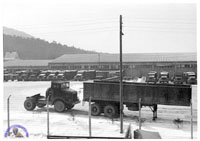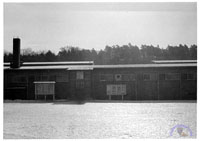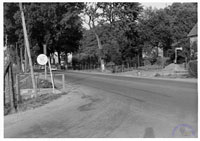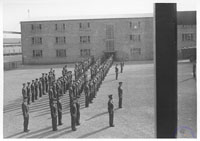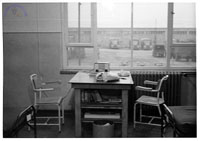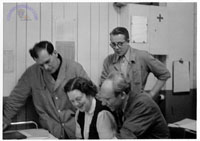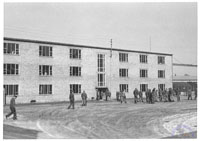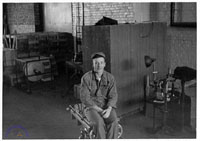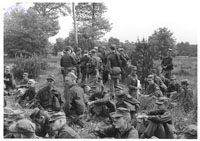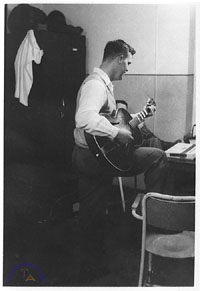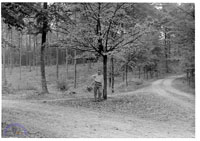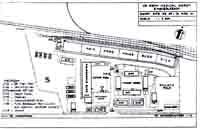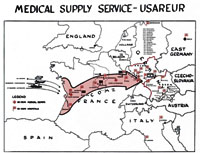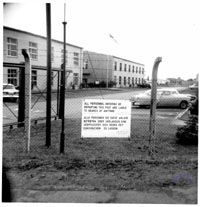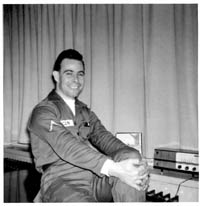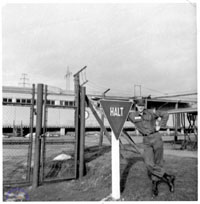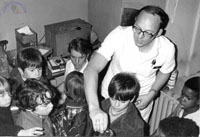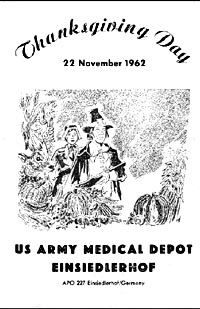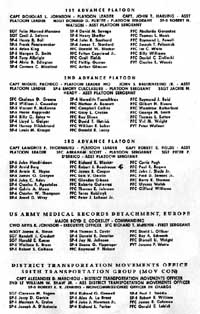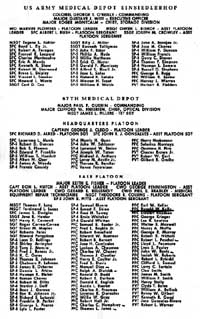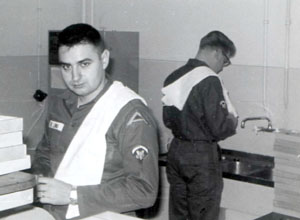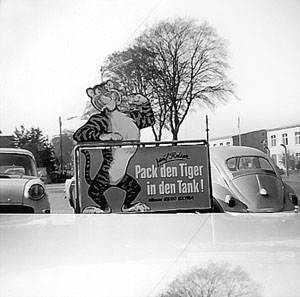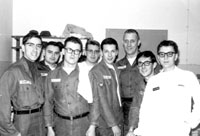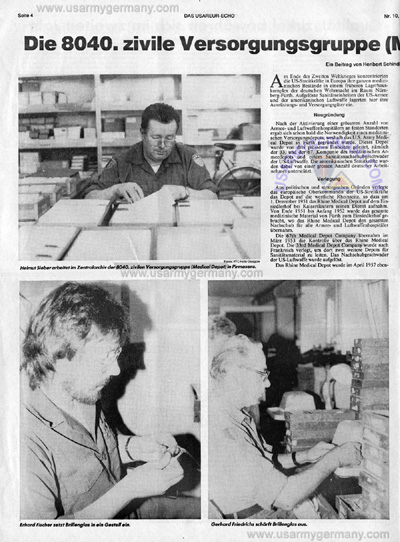| If you do
NOT see the Table of Contents frame to the left of this page, then
Click here to open 'USArmyGermany' frameset |
|||||||||||||||||||||||||
|
US Army Medical Depot, Einsiedlerhof |
|||||||||||||||||||||||||
|
|
|||||||||||||||||||||||||
|
|||||||||||||||||||||||||
|
|
|||||||||||||||||||||||||
| Rhine Medical Depot | |||||||||||||||||||||||||
| 1952 | |||||||||||||||||||||||||
| (Source: Email from Allen Kolons) | |||||||||||||||||||||||||
| On 26 Jul 1952, I was a “drafted” Private on a train from Sonthofen, Germany. I asked the conductor to tell me when we get to Einsiedlerhof. The train stopped and I got off onto a short wooden platform that had a little shack with a long sign stating “Einsiedlerhof”. There was a Corporal, George Vasel, waiting for me with an Opel staff car. A few minutes later I arrived at the RMD. I was assigned to the 7779 Central Medical Materiel Agency (CMMA). This was a detachment of about 60 men. It’s function was to received orders from various hospital units and prepare shipping information for the RMD. Its commander was Lt. Col. Findlay F. Flatter, who reported directly to the Surgeon General in Heidelberg. We were stationed at the RMD for rations and quarters only. I was assigned a MOS of 1400 Machine Accounting Specialist (IBM) to operate the IBM machines used to prepare reports. I have in my possession a copy of the Souvenir Booklet, 1 st Anniversary 1 Dec 1952, which was issued by the RMD. There are several important items mentioned, which I call to your attention: 1. Ground was broken for the RMD in May 1951 and in October, the 33rd Army Medical Depot and attached units were ordered to Einsiedlerhof. The last of the supplies, equipment, and personnel left Fürth on 30 November and on 1 December 1951, the Depot was in full operation. 2. The troops were housed at the Landstuhl Army Medical Center while awaiting completion of the new brick billets at the RMD. It was the latter part of February 1952 when the duffel bags were once more packed as the enlisted men prepared to move into the new billets with the depot area. 3. The knee-deep mud soon disappeared as gravel was spread in the area and the streets were paved. An extensive grounds beautification program began with the building of fences, planting of grass and flower, and the setting of trees and shrubbery. 4. On 31 May 1952, the EM club was opened. A baseball diamond, combination tennis-volleyball court, and horseshoe pits were built. I reported to W/O Clarence Kraus, a former master sergeant who was originally stationed at the Fitzsimmons General Hospital, and was given the choice of accepting a cut in pay and promotion to Warrant Officer and go to Germany, or keep his stripes and go to Korea. We had two Quonset huts for operations, but no IBM machines had arrived yet. Most of the enlisted personnel arriving were sent to Lenggries, Germany, in the Alps for IBM training. I and another private, Dick Benack had previous IBM experience and were not sent for further training. Once a week, an Air Force Sergeant from the Depot, would give us about 100 IBM cards to prepare a shipping list. Dick and I would go to the motor pool and draw a 2½-ton truck. We would drive to the Engineer Depot on the other side of Kaiserslautern, and wait to get to use one of their accounting machines to print the list (about one minute of processing). Then we would return to the RMD and give the Sergeant the cards and the list for shipping. That was the end of our work week. We had permanent pass possession and could leave if we had no work to do. Incidentally, we had American security guards on the gate, Polish guards walking around the fence, German putzfraus cleaning our rooms, German KPs in the mess hall. We had a tough time getting used to the “ration and a half” hospital rations, fresh milk, butter, cheese, and eggs. We would go into the mess hall and take a bottle of milk, a stick of butter, and a stack of bread. When we worked at night later, we would go to the mess hall for a late snack with the security guards. We had eggs fried to order, bacon, sausage, and salami. I had no choice but to gain weight. I found that the infantry units in Kaiserslautern ate from the Army menu, a single ration, and included powdered eggs and milk. They had no fresh items like we had on the hospital menu. It was like two different worlds. On 6 Aug 1952, I was promoted to PFC. When the IBM machines came in during the fall of 1952, Dick Benack and I volunteered to supervise two groups during the night shift. We would do most of the report preparation and this left the day shift with very little to do. Late fall 1952, I volunteered to drive Lt. Col. Flatter and Capt. Panker, (our CO) to COMZ Hq. in Orleans, France. Capt. “Smoky Joe” Joseph F. Panker was called up from the reserves and had been a saxophone player for Jack Teagarden’s band. We later found out the reason. The 7779 CMMA was going to break up into two segments, one in Orleans, and the other to stay in the RMD. On 19 Mar 1953, I was promoted to CPL. On 20 Oct 1953 Special Orders 153, a group of 43 men were transferred from RMD to Orleans, France, APO 58. I arrived in Orleans on 26 Oct 1953. It was a real “hell hole”. Mud everywhere and it was a “spit and polish” fortress. We were not allowed to build on French soil, so we were given and old fortress in Orleans for billeting. My group was given an abandoned horse stable with one window, one door, three pot belly stoves, and no running water. We had a canvas Lister bag of water for drinking. Cold water showers were in another building, hundreds of feet away. I took a top bunk by the door so I could breathe. I went to dinner the first night with my First Sergeant, and while we were standing in line in the mess hall, I noticed that there were Sergeants of all three grades working behind the counter as servers, and washing pots and pans. I asked my Sergeant what was going on, and he told me that there were too many officers and not enough enlisted men on this post, so the Sergeants had to work in the mess hall. Our group didn’t haven’t to worry, as we were there for rations and quarters only. He had been in the Army for 22 years, but this was too much. He was applying for retirement early. I decided this was too radical a change for me, so I took a 15 day leave and went back to the RMD and stayed in my old room in the brick barracks. On 08 Nov 1953, I received my Special Orders 236 transferring me from Orleans to Bremerhaven, back to the States, and inactive reserve duty to complete my eight years service. I understand that now all of the old units were either transferred or disbanded. It appears that the Kaiserslautern/Einsiedlerhof area has become one of the largest cities in Germany. I see that Einsiedlerhof has airports and expanded military facilities. The maps show many new roads and apparent industrial area buildup. I doubt I would recognize it today. I have fond memories of eating wienersnitzel and schweinesnitzel at Suzie Barden’s Gasthaus down towards Vogelweh, and drinking at the Bamboo Club in Kindsbach. Now I see that there is a whole new culture in the area, including strip clubs, entertainment, and sport centers. ADDITIONAL INFORMATION Another item of interest about the Rhine Medical Depot. When I arrived there in 1952, I was told that it was the 2nd largest medical depot in the world. Where was the largest medical depot? Right here in my home town of St. Louis, MO, at 12th and Spruce in the Mart Building, downtown. I had to go to Germany to find that fact. |
|||||||||||||||||||||||||
|
|||||||||||||||||||||||||
|
|||||||||||||||||||||||||
| From a defense and supply standpoint, it was later decided to establish a medical supply depot weat of the Rhine River. Ground was broken for the Rhine Medical Depot in May 1951 and in October, the 33rd and attached units were ordered to Einsiedlerhof, Germany. The last of the supplies, equipment and personnel left Furth on 30 November and on 1 December 1951 the Depot was in full Operation. The troops were housed at Landstuhl Army Medical Center while awaiting completion of billets at Rhine Medical Depot. It was the latter part of February 1952 when the duffel bags were once more packed as the enlisted men prepared to move into the new billets within the depot area. The knee-deep mud soon disappeared as gravel was spread in the area and the streets were paved. An extensive grounds beautification program began with the building of fences, planting of grass and flowers; and the setting of trees and shrubbery. Facilities for entertainment were given a start with a "make-shift" EM Club in one of the office buildings and movies in the mess hall. On 31 May 1952, the present EM Club was opened, On 8 August 1952. the building to be used as a combination classroom, theater and chapel was opened with appropriate dedication services. A baseball diamond, a combination tennis-volleyball court, and horseshoe pits were built. The Depot personnel became very active and successful in sports. One of the Depot teams reached the finals of the Rhine Military Post Softball Tournament. |
|||||||||||||||||||||||||
|
|||||||||||||||||||||||||
| (Source: EUCOM Medical Bulletin, June 1952) | |||||||||||||||||||||||||
| The Rhine Medical Depot is a Class II installation which houses a variety of units with somewhat varied missions: 33d Army Medical Depot, 67th Army Medical Depot, 73d Medical Materiel Squadron, 235th Medical Supply Detachment, 535th Medical Supply Detachment, 503d Optical Repair Unit, 7779th Central Medical Materiel Agency, EUCOM Central Medical Records Agency, 8054th Labor Service Unit, and the 8056th Labor Service Unit, An examination of the history of the operation of this depot the past few months reveals an increased workload, as seen in line items handled: the loss of trained personnel; the utilization, therefore, of untrained personnel; and the work involved in Air Force stock allocation, The considerstion of these factors may answer some of the questions that come to mind about the service, or lack of service, offered by the depot. |
|||||||||||||||||||||||||
| Big Picture report follows an Army WAC sergeant who visits the Eye Clinic at Landstuhl Army Hospital and shows the process of ordering and delivery of a pair of glass through the Optical Section of the Rhine Medical Depot, Einsiedlerhof. | |||||||||||||||||||||||||
| 1954 | |||||||||||||||||||||||||
| (Source: STARS & STRIPES, Jan 1, 1954) | |||||||||||||||||||||||||
| The Rhine Medical Depot (RMD), located at Einsiedlerhof near Kaiserslautern, receives and stores all classes of medical supplies for issue to US Army and Air Force installations in Germany. CO of the depot is Lt Col Richard H. Orth who also serves as CO of the 67th Medical Depot, the parent unit that operates RMD. (The medical depot was originally located at Fuerth near Nurnberg, but was moved two years ago to the west side of the Rhine River like most of the other EUCOM depots in Germany.) Other units located at Einsiedlerhof that carry out part of the medical supply mission are the 7373rd Medical Services Squadron (Air Force) and a base platoon of the 33rd Army Medical Depot at Fontainebleau, France. The depot has many of the support facilities of a typical small Army base, including a movie theater, PX, EM club, library, chapel, a tennis court and a baseball diamond. Some of the primary activities at the depot are as follows: Optical Manufacturing Division - this department provides eyeglasses for soldiers and airmen serving in Germany and is the only place where glasses for the US military and their dependents in Germany are made. Maintenance Division - this activity services and repairs all US medical technical equipment in Germany. Five teams from this division travel throughout Germany with their maintenance vans and stop at hospitals and other US medical installations to repair and maintain medical equipment. The teams work the entire medical curcuit in Germany about every six months. They will make separate trips to installations for emergency repair work as required. The Maintenance Division is equipped to repair any type of medical equipment, from a bedside table to a massive X-ray machine. Mobile medical vans operated by Army and Air Force units in Germany are sent to RMD periodically to be overhauled. Besides the day-to-day routine work done at the depot, RMD also plays an important role when emergencies arise. It distributes all of the influenza vaccine to US installations in Germany and provides emergency iron lungs to augment the supply of the US hospitals in Europe. Two hospital trains also make scheduled runs from the depot to Verdun and Frankfurt. |
|||||||||||||||||||||||||
| (Source: STARS & STRIPES, May 23 & Dec 16, 1954) | |||||||||||||||||||||||||
| (May) The Rhine Medical Depot has over 8,000 items in storage. (Supplies on hand at the depot average about $6,500,000.) The complex comprises 24 acres of warehouses, maintenance shops and administration buildings. Current CO of the depot is Lt Col Richard H. Orth. The parent unit that operates the depot is the 67th Army Medical Depot. Assisting the 67th are a base platoon from the 33rd Medical Depot (located at Fontainebleau, France) and an Air Force medical materiel squadron (commanded by Lt Col James H. Marsh). In addition to the American military personnel, close to work at the depot. On a rail spur adjoining the huge complex are two Army hospital trains: the 37th and 325th. RMD ships supplies by air, rail and truck to some 29 major installations (= hospitals) which in turn supply several hundred smaller installations (= dispensaries and other units). In 1953, the RMD Maintenance Division - headed by Maj Joseph L. Schearer - repaired 27,402 medical items valued at $3,782,000. The RMD Optical Division has a staff of 13 soldiers, two airmen and three German members of a labor service unit stationed at Einsiedlerhof. (Dec) The Rhine Medical Depot recently celebrated its third anniversary at Einsiedlerhof. RMD is the largest medical supply depot in Europe and is also one of the few depots that is staffed by Army and Air Force personnel, as well as German civilians. Covering an area of 24 acres, the depot stores more than 15,000 items (ranging from aspirins to large X-ray machines). In addition, about 6,000 spare parts are kept on hand for repairing medical and dental equipment used at military hospitals and dispensaries throughout Europe. RMD services about 650 stations and their satellites, shipping medical supplies by air, rail and truck. It also fills emergency requests for vital drugs. Maintenance Division, RMD -- the division is equipped to repair all types of medical and dental equipment. It also operates two mobile repair shops that make semi-annual visits to all medical facilities to inspect medical and dental equipment. Optical Division, RMD -- this division is responsible for fabricating approximately 35,000 pairs of glasses (spectacles) each year for members of the Army, Air Force and Navy stationed in Germany. CO of the Rhine Medical Depot is Maj Russell E. Julian. |
|||||||||||||||||||||||||
| 1955 - 1956 | |||||||||||||||||||||||||
| (Source: Email from Earl Gates, Maintenance Section, RMD, Jan 1956- Jan 1956) | |||||||||||||||||||||||||
| I was based at the then Rhine Medical Depot from January 1955 to January 1956. I had been trained in St. Louis as a "Basic Medical Equipment Repairman," but they had far too many of us in that MOS in Germany and I put my time in there as a clerk in the Maintenance Section. Notes on Time Spent at Rhine Medical Depot, Einsiedlerhof, Germany by Earl Gates. I arrived at the Rhine Medical Depot (RMD) as a Private, E-2, in January 1955. I entered Germany at the port of Bremerhaven aboard a WW-II Liberty Ship, the USS General Hahn, after a stop at Southampton to off-load some of our Airman passengers. We left the Brooklyn Navy Yard with 2000-3000 Army troopers and Air Force Airmen 10 days or so earlier. We had typical North Atlantic winter weather, which meant they stopped choosing people from our forward compartment two days out because the motion was so severe that seasickness kept everyone in their four-high bunks. The ship’s bow plowed under each wave and we weren’t allowed on deck because the decks were under water much of the time. Landlubbers like me worried at the entire ship shuddering when the propellers cleared the water as waves passed under the stern. Wave crests were higher than the ship’s bridge as we wallowed through the troughs. The ship’s newsletter advised us we were experiencing “moderate seas.” They could have fooled me. We traveled by train from Bremerhaven—my first experience with European-styled rail compartments—to a replacement center in southwestern Germany (Zweibrücken?). There, they lectured that the tension with the Communist East was very real and that we should take the occasional alerts seriously because the Russian Army still made threatening moves at the borders. We traveled to RMD by truck. There, we were told that we were in the process of expanding and absorbing the role of another medical depot that had been based in France. According to the explanation, the DeGaulle government had decided it would be better off with a diminished US military presence on their soil. The North Atlantic Treaty Organization was still new and there was a lot of jockeying around among the members. West Germany, where the RMD was located, didn’t become a member of NATO until mid-1955. I had been drafted a year earlier and inducted less than a week after I had completed the requirements for a BA degree. After Basic Training in Arkansas and a few weeks of Medic’s training in San Antonio, the Army sent me to St. Louis to become a Basic Hospital Equipment Repairman. The “Basic” meant that I was qualified to service the rudimentary equipment usually found in an Army MASH unit on the front lines. The real Repairman had at least a full year of training and could work on the big stuff in the base hospitals. There was no active fighting going on at the time so there were no MASH units. That meant they had too many of us “Basic” types and needed to find a use for us. My entire class of “Basics” bounced individually from one post to the next over several months in the States before being sent overseas. The RMD had 10 or 15 of us at any given time and they were authorized for none so we did other things, mostly non-maintenance activity in the Depot Maintenance shop. There were a half-dozen or so of the real Army repairmen in the shop doing their thing on American manufactured equipment and about as many German civilian technicians working on German manufactured gear. When Army European hospital personnel could no longer cope with a broken piece of equipment, they sent it to our shop where we had more exotic tools and knowledge. When I first arrived, I worked on cleaning, crating, and boxing repaired equipment going back to hospitals. German civilian carpenters did the real crating and boxing in a shop at the south end of Building 2115 under the rigorous supervision of Fritz, a large-sized former Sergeant Major in the German Army. If we GIs were nice, Fritz would let us lesser humans use his shop to crate and pack things such as fine china and cuckoo clocks we were shipping home. After a week or two, I was shifted into the Maintenance records office when the GI who had been doing the work was rotated home. I was the clerk in that office for the rest of my time in Germany. While I was there, the Depot looked exactly as shown on the map in the “USAMDE Briefing Brochure, early 1960s,” dated 31 Mar 61. As I recall, buildings 2108, 2109, and 2110, served as troop housing on the upper two floors. The four-man room to which I was assigned was on the second floor of Building 2108. The ground floor of that building served as home for the very nice little library and for the Base PX where I bought the Agfa 35-mm camera that took our family pictures for the next 30 years. I also bought cigarettes by the carton even though I didn’t smoke. Many of us participated at some level in the gray market as a favor to our German civilian friends because there were no taxes involved at the PX. The ground floor of Building 2109 served as Company Headquarters and day room. Such weaponry as existed on the base was locked up there. Selected individuals were “issued” one of the M-1 Carbines stored there. The assignment was supposed to rotate, but mine didn’t. Each time we had an Alert—once a month or so—or when we went on a field maneuver, those of us with a carbine assigned would report to the squad room to pick up the weapon and carry it until the event was over. I don’t know who cleaned the rifle, but it wasn’t me. At least once while I was there, we took a field weekend at the rifle range where we went through the motions of “qualifying.” We were led to believe that we were experiencing far more emphasis on field exercise and inspections than had our predecessors because someone in the command hierarchy had decided we should be able to pass for soldiers even if we were Medical Corps. The ground floor of Building 2110 had the Optical Shop where, as far as I know, they ground all the lenses for all the Army spectacles in Germany and perhaps in Europe. There was also a dental clinic on that floor of that building. An Army dentist showed up occasionally to handle appointments for the people on the base. In spite of the fact that I was always broke (the local rank backlog did finally break in time for me to make E-3 six months after I arrived, but I made E-4 less than two weeks before I left to come home), I was too far from home to visit on leave, and my mastery of the language was far from adequate, I now treasure my time at RMD. At the time, among other inconveniences, I resented having to fall out each morning and noon into formation in what the map calls the “Troop Area.” Even that had its comic relief. Often, while were standing in formation, jet fighters would roar in at low altitude for a landing (I believe at Ramstein AB) and drown out the lecture we were receiving. Our First Sergeant, a former boxer, liked to hear himself talk and would end up apoplectic and shaking his fists in frustration at the planes. They flew low enough that we could often make out the pilot’s helmet through the plane’s canopy and we were convinced the pilots knew the effect they were having on the ground. As compensation for all this inconvenience, I was exposed to things not available on the farm at home. In Kaiserslautern, I saw and heard my first real, live opera (written by an Italian, sung in German) and saw my first live ballet (music by a French composer, danced by German dancers). By the magic of the three-day pass and tours offered by American Express, I visited the major cities in Switzerland and stayed in my first four star hotel. By the same magic, I walked the banks of the Seine, rode Paris taxies, and saw Winged Victory and The Madonna With Child in the Louvre. I was able to hitch a free ride on a DC-3 to England and spend four days living in the non-commissioned officers’ section of the British Enlisted Men’s Club in London. I watched the Changing of the Guard at Buckingham Palace and saw three Broadway plays starring world-class actors (Rex Harrison in Bell Book and Candle for one). When I was ready to return to Germany, there were no flights, so I shipped aboard an over-night Channel ferry from Dover to Ostend (I think) and rode trains back to Kaiserslautern through two or three countries with checkpoints at every border. I was in uniform, carrying my US Army ID and no one blinked at my not having a passport. I took a boat on the Rhine to the Rock of the Lorelei and back to Bingen, a town not much changed for hundreds of years. I visited Heidelberg Castle. I visited Munich and listened to the singing over bier at the old Hofbrau Haus. I watched an ice show in Garmisch-Partenkirchen that rivaled any ice show I’ve seen since. I also managed to get myself nearly killed in a traffic crash when an inebriated commissioned Army officer rammed into the rear of my roommate’s motorcycle (on which I was a passenger) as we slowed (with signals) to turn into the RMD front gate. The MPs let him proceed with a warning and we learned later that he had ended up in the hospital after wrapping his car around a roadside tree just a mile or two further down the road after leaving the scene of our accident. I remember the food as good. German civilian employees did all the KP duty while US Army cooks did the food prep. The Enlisted Men’s Club was outstanding, with regular shows and excellent food and service. I worked evenings at the post movie theater for extra cash, first as a ticket seller/collector, and then as projector operator. It became a comfortable routine to drop by the EM Club after the theater closed each evening for the best beer and grilled cheese sandwiches I ever ingested. I received flight priority for coming home and my orders called for a simple connection out of Frankfurt. That got complicated when someone decided that 10-15 of us already in Frankfurt should take the train to Munich and fill some empty seats on the last planeload of an entire unit being rotated home. That change led to two nights in a Munich hotel (where we learned we were to pay for our own meals although we had been given no travel advance to cover such) with a group of GIs and their wives and kids waiting for the plane to take off. We weren’t allowed to leave the hotel because a replacement engine had to be flown in from Amsterdam and they didn’t want to come looking for us if the engine appeared and got installed unexpectedly. At the time of the changes in Frankfurt leading to my flying out of Munich, my orders had not been fully re-cut to get me any further than (then) Idlewild Airport in New York City, the destination of the unit rotating. After a lucky Greyhound bus ride to Fort Dix, some very kind civilian clerks worked past their 5:00pm quitting time to get me on a plane to Chicago Midway Airport and then on a train to Fort Sheridan where I mustered out on 16 Jan 1956. |
|||||||||||||||||||||||||
|
|||||||||||||||||||||||||
| 1959 | |||||||||||||||||||||||||
| (Source: Email from Fred S. "Zeke" Davis) | |||||||||||||||||||||||||
I was stationed at Einsiedlerhof from Aug. 1959 thru July 1963. I arrived with four other troops: Thomas L. Forbus, from Sylacauga, Al., William Long of Richmond, Va., Warren Troute, and an another guy that I can't remember his name at present.
When I got to Kaiserslautern Bahnhof we were picked up by Pfc. Paul Schwab and Pfc ______ Gearhart.
We arrived at the depot on Thursday. On Saturday night, Pfc Orvill Smith, of Manafest, La. (now deceased) and Pvt Howard E. Christmas of Atlanta, Ga., took me and Forbus up to the O.D. which was Capt. Griesso and got us a pass to go to town. Back then the dress code to go off post was jacket/tie or uniform. No bluejeans,short sleeve shirts, or tenny shoes. If (you violated the rules) you were restricted for two weeks before you could get another pass. During my four years there I played center for the Depot football team. I made the 7th Army football team and tried out for th 7th Army basketball team. I was first assigned to the grounds crew with Sp4 Green and a German worker named Hans. Later we got a new troop named Werrner Hotz. He was a German who had joined the Army to get his citizenship. I transferred then to the Shipping & Recieving Dept. Then I went to the Loose Issue Section for about two years. Some of the people in that section were Werrner Jung, a Capt. in the L.S.G., U.S. 1st Lt. Pachico, Otto Haulk, a little guy we called "Sleepy". I transferred the U. P. for the last part of my tour. We had Donnie Atkins "Mr. Spiteshine", he was from W.Va., Donald Lacey from Colo., Davenport from Pa., and a guy named Humphery from Tn., and William Smith from Colo. and several other men I can't recall. I married a girl from Kaiserslautern. We had two boys together. When I rotated back stateside I got a divorced and later remarried. I still keep in touch with my ex-wife and kids. I spent the best years of my life in Germany. Hopefully me and my wife will take a trip back over there. We drank a lot of beer, Cognac, and had a lot of hand to hand combat in the Gasthaus. During my stay over there we had the "Berlin Crisis and the Cuban Blockade." During that time we pulled 24hr. guard at Warehouse 4 which was at Pirmasens. During this time there was no leaves and when you were on pass you had to have an address so you could be found. In the Optical Shop I remember Calvin Moon and Tony Antinco. Our Depot Commander was Lt Cpl Dempsey, afterwards it was Maj Gushin. Our CC was Capt. Griesso. Our 1st Sgt was Jocobs. I sit around and have some pleasant thoughts and some not so pleasant about my time over there. We had alerts every month at 2 or 3 oclock in the morning then around 6 am they would call it off. I could go on and on about the Depot and the people that was there when I was. |
|||||||||||||||||||||||||
| Briefing Brochure | |||||||||||||||||||||||||
| 1951 - 1961 | |||||||||||||||||||||||||
| (Source: Briefing Brochure, US Army Medical Depot, Einsiedlerhof, early 1960s) | |||||||||||||||||||||||||
| SECTION I
- INTRODUCTION: LOCATION: The United States Army Medical Depot, Einsiedlerhof, is located in the Kaiserslautern Post area of Northern Area Command, approximately five miles west of Kaiserslautern, and five miles east of Landstuhl on Highway N-40. Highway N-40 is considered to be a main transportation artery between France and Germany. BRIEF HISTORY: Construction of the depot began in June 1951 and was completed in May 1952. GO 67, Hq, European Command, dated 12 October 1951, established Rhine Medical Depot at Einsiedlerhof, Germany, and on 15 November 1951, the installation opened for supply operations as the only medical depot in Europe. Supplies and personnel were transferred at this time from Fuerth Medical Depot, which had been deactivated. Rhine Medical Depot was redesignated US Army Medical Depot, Einsiedlerhof, in April 1957, and the installation was assigned to Communications Zone, Advance Section, Verdun, by GO 20, Hq, US Army Communications Zone, dated 6 June 1957. The depot was assigned as a subordinate command of TASCOM, Europe, effective 28 February 1960, as a result of redesignation of ADSEC, USAREUR/ComZ. TASCOM was redesignated 4th Logistical Command on 1 July 1961. MISSION OF USAMDE: The mission of the US Army Medical Depot, Einsiedlerhof, is to receive, store and issue medical supplies and equipment to those installations within its assigned distribution area; maintain and repair technical medical equipment, provide technical medical assistance visits to stations within zone of responsibility, and fabricate spectacles, as directed by higher headquarters. Further, to maintain in storage certain reserves of medical material and to process and store returned material from medical installations. SECTION II - ORGANIZATION OF USAMDE: US Army Medical Depot, Einsiedlerhof, is operated by the following units: |
|||||||||||||||||||||||||
|
|||||||||||||||||||||||||
|
|||||||||||||||||||||||||
| Currently, lodger units billeted and supported within the depot are: US Army Medical Records Detachment, Europe, a 9th Hospital Center unit, and District Transportation Movement Office, 594th Transportation Group (Movement Control), an element of 594th Transportation Group. In addition, logistical support is furnished Kaiserslautern Detachment, US Army Mortuary System, Europe, located in the vicinity of the depot. SECTION IV - MEDICAL SUPPLY SYSTEM, EUROPE: Communications Zone medical depots are located at Croix Chapeau, France, Vitry le Francois, France, and at Einsiedlerhof, Germany. Accountability for stocks in each of these storage activities is maintained by US Army Medical Supply Control Agency (USAMSCA), located at Poitiers, France. |
|||||||||||||||||||||||||
|
|||||||||||||||||||||||||
| Should Seventh Army become operational, the medical supply support for the field army will be furnished by the 67th Medical Depot, a Seventh Army unit currently attached to US Army Medical Depot, Einsiedlerhof, for operational control. This unit is organized under TOE 8-667D, Army Medical Depot, and is capable of establishing three advance platoons to serve as supply points for each corps. The base platoon will service the balance of the field army in addition to supporting each advance platoon. | |||||||||||||||||||||||||
|
|
|||||||||||||||||||||||||
| Introduction of Electronic Accounting | |||||||||||||||||||||||||
| 1952 | |||||||||||||||||||||||||
| (Source: Excerpt from an article written by Lewis L. Johnson in the EUCOM Medical Bulletin, July 1952) | |||||||||||||||||||||||||
| Electric Accounting Procedures During 1952, two separate organizations of the Medical Service in EUCOM will undergo complete revision of their accounting and statistical operations. These organizations will be mechanized with what is known as electric accounting machines. With the completion of these revisions, the Medical Service will be on a parallel basis with four of the other technical services in EUCOM as well as the Air Force. At the same time the methods observed will closely follow those that you will observe in Stateside depot and headquarters operations. In the Rhine Medical Depot in the Stock Control Division, the following general stock accounting and stock reporting functions will be performed by EAM equipment: The daily transaction register is the accountable and auditable record of the depot transactions, its subsidiary due-out reports, and their monthly analyses of transactions, particularly issue and demand transactions. And by demand is meant those items actually requisitioned by supply officers although substitution was made by the depot and a different item was actually shipped. Also the preparation of Army shipping documents will be automatically prepared by EAM equipment. The movement of the "G" on German-procured items is largely because of the use of EAM equipment and will make it a bit easier for automatic correlation of figures. The last major operation at the depot level will be stock status reporting between the depot and the 7779th Central Medical Materiel Agency. These operations will be standard both with Army and Air Force operations. The second major operation to be mechanized is the 7779th Central Medical Materiel Agency where the determination and computation of command requirements is a major responsibility. Specifically the following operations are now being planned: First, computation and preparation of the ZI requisition; secondly, preparation of command stock position reports; thirdly preparation of command stock catalogs; and fourthly, analyses of issues and demand and correlation of these figures to the monthly replenishment of stock. The exact date that the conversion of the records will begin can not be yet determined, as this date is dependent upon arrival of the equipment from the Zone of Interior. Procedural plans, as they are now being formulated, are centered around one of the more recent developments of the equipment manufacturer. This development is known as "mark sensing." Use of this device permits the "punching of cards" without a keypunch operation, or at least, it will reduce the manual punching of cards to what we feel is a minimum. |
|||||||||||||||||||||||||
| 1961 | |||||||||||||||||||||||||
| (Source: USAREUR Medical Bulletin, July 1961) | |||||||||||||||||||||||||
| US Army Medical Depot, Einsiedlerhof An important link in the chain of United States Army medical installations that cover Europe today is the United States Army Medical Depot, Einsiedlerhof, the major medical supply distribution depot in the command. Commanded by Lt. Colonel Richard W. Dempsey, MSC, the depot at Einsiedlerhof provides complete medical supply support to all medical treatment facilities in Germany and Europe. In addition, the depot stockpiles large quantities of emergency medical supplies. The depot is located in the Kaiserslautern Post area of Northern Area Command, approximately five miles west of Kaiserslautern on Highway N 40. Kaiserslautern, the largest city in the immediate depot vicinity, is located in the Rhine Palatinate area of Germany approximately fifty miles west of Mannheim and Heidelberg. The depot has been operational at Einsiedlerhof since November 1951 and until March 1957 was known as the Rhine Medical Depot. The depot is a subordinate command of the Theater Army Support Command, with headquarters at Verdun, France. The mission of the depot is to receive, store, and issue medical supplies and equipment to US Army installations throughout Europe and the Middle East. Requisitions are processed through the depot using the most modern Automatic Data Processing equipment. Supplies are usually on their way as soon as transportation can be arranged. Emergency requisitions for drugs or extra equipment can be filled in a matter of minutes and be shipped by air to the area where needed. All supply transactions are carried out under the supervision of Major Richard S. Rand, MSC, who is Chief of the Storage Division. The depot is also responsible for the repair and maintenance of medical technical equipment in its distribution area. Maintenance teams from the depot make periodic visits to the larger hospitals in the command in order to assist local maintenance personnel in properly caring for expensive items of equipment. Equipment of all sizes and kinds is checked by the maintenance teams so that breakdowns may be avoided. Special attention is paid to the routine maintenance procedures such as oiling and minor adjustments. If the equipment is not working properly, it is repaired or adjusted by the technicians and if this cannot be done on the spot, the equipment is shipped to the depot for repairs. The Chief of the Maintenance Division is Major Joseph P. McCaffrey, MSC. The depot Optical Division fabricates an average of 7000 pairs of spectacles monthly for Army and Air Force personnel in the theater. The Optical Laboratory under the direction of Major Clifford W. Knieriem, MSC, is staffed with highly qualified technicians both military and civilian. Important in the operation of the depot is the 67th Medical Depot (Army), a Seventh United States Army unit, which is attached for the purpose of serving as the major operating unit of the depot. Personnel of this unit, both officers and enlisted men, fill positions throughout the depot and provide the bulk of the personnel required to operate the depot. In addition, they are assigned specific jobs within their own unit and are trained and prepared to perform the mission of a field medical depot in support of Seventh Army. The 67th Medical Depot is commanded by Major Paul P. Gushin, MSC. Key military personnel in the depot organization, other than those mentioned above, are Major Gustave J. Witt, MSC, Executive Officer; Captain Franklin C. Hansen, MSC, Plans and Training Officer; Captain Louis A. Normand, MSC, Chief, Miscellaneous Services Division; Captain Roger Montcalm, MSC, Adjutant; and 1st Lieutenant Miguel Pacheco, MSC, Troop Commander. The depot personnel are justly proud of the enviable record they are building. While the work of the depot is actually to receive, store and issue the supplies quickly and efficiently without loss or damage, much of the work in the depot lies along accounting lines. Every item from an aspirin to an expensive X-ray machine must be checked into the depot and then upon audit must be produced in the depot or the flies must show a signed shipping receipt indicating where and when and how the item was shipped. A recent thorough audit of the records of the entire depot showed the accounting for supplies to be most commendably efficient. Today, as the depot is entering the tenth year of operation at Einsiedlerhof, it stands ready to provide around the clock supply, maintenance, and optical support to the medical treatment facilities throughout the command. |
|||||||||||||||||||||||||
| Maintenance Division | |||||||||||||||||||||||||
| 1963 | |||||||||||||||||||||||||
| (Source: USAREUR Medical Bulletin, Dec 1963) | |||||||||||||||||||||||||
| Medical Maintenance in USAREUR The U. S. Army Medical Depot, Einsiedlerhof, Germany, commanded by Colonel Eli E. Daman, MSC, is an important link in the chain of Army medical installations in USAREUR. In addition to being the major medical supply distributor and the major fabricator of spectacles, the depot has a very well-equipped Medical Equipment Maintenance and Repair Activity. The Maintenance Division, U. S. Army Medical Depot, Einsiedlerhof, is a 5th echelon medical maintenance activity that provides direct medical maintenance support to all ECP accounts and Medical Service Areas located in West Germany, Berlin and Italy. This activity has the reponsibility for providing medical maintenance repair and return service of audiometers and all types of dental handpieces for U.S. Army Medical and Dental treatment facilities in USAREUR. The Maintenance Division also schedules and provides highly skilled Medical Maintenance Repair Technicians to perform the mission of providing technical maintenance assistance visits a least once each year to all the medical and dental treatment facilities in Germany and Italy. The Maintenance Division was established in its present location at the Einsiedlerhof Medical Depot (Webmaster note: actually, the Rhine Medical Depot as it was known as that time) in 1952, and has been moulded over the years into the highly technical and efficient medical maintenance facility that it is today. It provides a high standard of medical maintenance repair and return service-to-user on all medical equipment used by the U. S. Army Medical Service in Europe. Among the items worked upon by the Depot are life saving equipment and complex instruments used in diagnostic or therapeutic laboratory, surgical and medical procedures. Staff The Chief, Maintenance Division, is CWO W-3 Phil E. Bradley, a school-trained officer. CWO W-3 Gerard E. Bellenoit serves as Chief of the Production Control and Inspection Branch. Mr. Willy Baer, a German National who has worked in the Maintenance Division since it first began operation, is the Chief Inspector and Assistant Chief of Production Control. Other key personnel in the Maintenance Division who contribute to its efficient operation are MSgt E-8 Thomas F. Long, NCOIC; MSgt E-8 Eugene Kahler, Repair Branch Supervisor and Chief Electronic Repair Technician; SP6 Leon Rollings, Shop Foreman and Production Control Specialist; Mr. Heinrich Kukowski, Chief X-ray Repair Technician. All personnel, both U. S. Military and German Nationals employed by the Maintenance Division, are highly qualified in their fields. They serve as machinists, welders, catalogers, supply clerks, painters, equipment packers and in a number of other jobs vital to this huge operation. The Maintenance Division is currently authorized three medical maintenance Warrant Officers; 11 U. S. military medical equipment repairmen; 8 German National medical equipment repairmen; 3 German National painters; 1 military machinist; 1 military welder. Wood Fabrication Branch The division also has the responsibility for the operation of a Wood Fabrication Branch which consists of a Carpenter and Facilities Maintenance Section and a Box and Crate Section; its authorized strength includes 9 U. S. military personnel and 10 German Nationals. Maintenance Repair Shops The maintenance repair shops are qualified to overhaul completely and rebuild the various items of medical equipment used by the Army Medical Service in Europe. The staff and maintenance personnel strive to achieve a better and more efficient maintenance operation by increasing their capability and production output. During the current fiscal year the maintenance shops have overhauled in excess of 4,500 items of medical equipment which had a dollar value of more than $750,000. In addition, approximately 1,500 items of medical equipment from depot stocks were received for complete operational testing and minor repair to insure that the equipment issued to the customer from depot stocks was in excellent operating condition and ready for use. |
|||||||||||||||||||||||||
| 67th Medical Depot | |||||||||||||||||||||||||
| 1960 | |||||||||||||||||||||||||
| (Source: Email from Calvin A. Moon, 67th Med Depot, 1960- ?; 1969-1974) | |||||||||||||||||||||||||
Noticed your site and enjoyed looking the information. I was stationed at Einsiedlerhof from October 1960 to 196? and again from September 1969 to 1974. I remember most of the people listed for the Thanksgiving Dinner. I just spoke with Henry Stelly, from Port Arthur, Texas. Henry is listed on the Dinner list. He, like me, just turned 65 and is retired. He worked in the Motor Pool and we had a good time going over old times. |
|||||||||||||||||||||||||
|
|||||||||||||||||||||||||
| 1961 | |||||||||||||||||||||||||
| (Source: Email from Robert J. Boudreaux) | |||||||||||||||||||||||||
I arrived at the 67th Medical Depot on October 20th, 1961. I started working in the warehouse as a forklift driver. Then I went to Maintenance repairs. This was in 1962.
In December 16, 1962, I came home on Christmas leave for 30 days. I then became a UP (Unit Police), or Gate Guard, and remained in that position for the rest of my tour. I left the 67th on October 16, 1963. That's when my tour ended.
I knew SP4 Lloyd Passmore (not on rosters), PFC Joseph T. Pribanich (deceased), SP4 Carmen Micalizzi, PFC Ronald W. Kelly, SP4 Calvin Moon. |
|||||||||||||||||||||||||
|
|
|||||||||||||||||||||||||
| 1962 | |||||||||||||||||||||||||
|
(Source: Email from Ronald W. Kelly, 67th Med Depot, 1962-65)
|
|||||||||||||||||||||||||
|
I was assigned to the 67th from May 1962 to May 1965 and was assigned to the Base Platoon. I also have a few pictures of the area and a Thanksgiving Day menu from the mess hall dated November 22, 1962.
I started out working in the motor pool and then transfered to the Gate guard section for about a year and then back to the motor pool where I was assigned as driver LTC Clark and we traveled all over south Germany and some parts of France. I returned to Germany in 1972 and was assigned to the 2nd General Hospital which is now Landstuhl Medical Center. Ronald Kelly |
|||||||||||||||||||||||||
1965 |
|||||||||||||||||||||||||
(Source: Email from Roger L DeLong) |
|||||||||||||||||||||||||
|
|||||||||||||||||||||||||
1971 |
|||||||||||||||||||||||||
(Source: Email from Alan D. David) |
|||||||||||||||||||||||||
| I am now retired from the U.S. Army (1965 - 1988). All total, I spent almost twelve years in Germany. My last three years were in Wuerzburg, at Emery Barracks. I was the Division Optician for the Third Infantry Division...the only optician in the entire Division! I was stationed at the Army Medical Depot in Einseilderhof from December 1971 through March of 1975. I found Roger DeLong's story and pictures to be very interesting (see email above). At that time, the parent unit had already been redesignated as USAMMCE (United States Army Medical and Material Center, Europe). I was assigned to the Optical Laboratory. The MOS designation for an Optical Laboratory Technician was 42E. My understanding is that the 42E MOS no longer exists and is a special designator under the 91Y MOS. That could be outdated by now, as well. I was reassigned to Fort Sam Housron, Texas. I was then sent back to Germany, to be reassigned to USAMMCE after the center had been relocated to Pirmasens, on Husterhoe Kaserne. I was in Pirmasens from 1979 through 1982. I was then reassigned to the Army Optical School (USAMEOS - United States Army Medical Equipment and Optical School) in Denver, Coloradoas an instructor from 1982 to 1986. Einsiedlerhof was a mixed bag for me...but more good than bad. The First Sergeant (who was actually a Staff Sergeant) for the center was a fellow named Orville D. Long, from Oklahoma. I recall that he could never say "Quadrangle". He always called it the "Quad-Triangle"! I can recall him saying, on numerous occassions, "We're going to have a formation in the quad-triangle at thirteen hundred hours!" Because of a medical profile, I worked in the orderly room for my first 90 days at the center. The Center and Installation commander was LTC William J. Standifer. He wasn't always the most popular person on the installation. I can recall that he had a 1953 Mercedes SL (150?) convertable that was real nice. Someone poured sugar in his gas tank one night. Of course, that destroys the engine after you run for a few minutes with the sugar in the fuel. I always got along quite well with both SSG Long and LTC Standifer. Here are some of the other names I recall from the Optical Lab during my time there: SSG Charles M. Burns; SP5 Mike Roedner; SP5 Frank Brownie; SP5 Tom Grove; SSG Lee O. Collum; MSG Ollie Lawton; SSG Robert J. Barclay; SSG Leslie Nuce; SP4 Jaun Oliveras; SSG Tom Hudson; SFC Eric Myer; SP5 Calvin Moon; SP4 Greg Simpson; SP5 Patrick J. Handley and German Civilian Wolfgang Schmidt. I am not positive, but I think the OIC of the optical Lab was Major Wilson. That may or may not be correct. I remember that he had reddish brown hair. Wolfgang Schmidt and I become pretty good friends. He drove in, every day, all the way from Kusel...over an hour's drive. To my knowledge, Wolfgang never married. He was an excellent optician and a really nice guy. SSG Lee Collum and I became very good friends. He is one of the best friends I have ever had. Lee retired in 1987 as a Master Sergeant. I lost track of Lee a few years ago and would love to hear from him again. I watched Lee and Cathy's two daughters, Lindy and Courtney, go from pre-school to high school. One thing that I recall very vividly is personally fitting the USAREUR Commander, a Four-Star General, with a pair of glasses at his headquarters office in Heidelberg. For the life of me, I cannot recall his name at this time. This was in 1974. I remember the ESSO gas station almost directly across the street from the main gate. The owner's name was Hans. I can recall tearing out those coupons from the gas ration book and handing them to Hans. I learned to speak pretty good German fairly quickly and I spent a lot of time out on the economy. Before getting into government housing, my family and I lived at Apfel Strasse #9 on the other side of Kaiserslautern. When we did get government housing, it too was on the other side of Kaiserslautern. It was a brand new high-rise apartment building, with an elevator, right next to the BBK Brewery. I was directly adjacent to the Kaiserslautern professional soccer team. We could actually look down and see part of the field from our balcony. We could also watch the German men peeing on the grass next to the sidewalk as the exited the stadium when the game was over. I always enjoyed going to the castle ruins in nearby Lanstuhl. And in Kindsbach, a small town between Einseilderhof and Landstuhl, the Gasthaus Schuff was great place to eat. |
|||||||||||||||||||||||||
1972 |
|||||||||||||||||||||||||
(Source: Email from Juan Martinez, 67th Med Depot, 1972-77) |
|||||||||||||||||||||||||
I was stationed with 67th Medical Depot from Sep. 1972 to May 1977. I worked with Germans in the Quality Control Department. My PLT SGT was SFC Taylor. I remember it so well. The day that I drove through the gate, I said to myself -- where are they taking me? I was a Private at that time and just went with the flow. I got lucky and was assigned to the Optical Platoon. I was a warehouseman at that time, so I figure they put me in the warehouse. I still can picture the entire Depot Complex. The formations in front of the orderly room, the mess hall across the orderly room. And the three barracks, one over the orderly room, one where all the optical personnel resided and the one above the PX. At that time I could not believe that this little complex had a theater, a PX, Dry Cleaners, we had it made. My Platoon Sgt. was SFC Meyers. If lucky I would see him once a day. I always remember him as a great person. Every morning after formation, we would do our policing around the buildings, then we would all head towards the gate into the warehouse complex. All my buddies when to the right towards the receiving office, I always made a left turn towards the services and supply building. I worked next to the Medical Maintenance Department. I was assigned to work with the local nationals and a few German soldiers (Webmaster note: probably Labor Service personnel). They trained me in Quality Control Assurance. I was the first soldier that they assigned to that department. I got along great with the people there, they liked me. I would get a clip board and a list of supplies to inspect daily, I was authorized to send expired medical supplies to the DRMO. I was given a 2 1/2 T, a Jeep and a forklift, so I had it made. I loved being at the Depot so much, it was great place to work, until they moved to Pirmasens. I had my world turn around, luckily I was married. We had to catch a bus to go to work, the warehouses were far apart, many others were unhappy. I left on March 1977 for Ft. Devens, MA. I can still remember everything, the people around me, it was a great assignment. Now am retired and living In Kansas. The 67th Medical Depot, was the place that inspired me to stay in the Army. I don't have many pictures, because at that time we worked, went to town and back to the barracks -- never really thought about taking any photos. That is my story of my time at the 67th Medical Depot. |
|||||||||||||||||||||||||
|
|
|||||||||||||||||||||||||
| 8040th Civilian Support Gp (Medical Depot) | |||||||||||||||||||||||||
| 1951 - October 1968 | |||||||||||||||||||||||||
| (Source: "Die 8040. zivile Versorgungsgruppe (Medical Depot) besteht seit 35 Jahren," DAS USAREUR ECHO, October 1987) | |||||||||||||||||||||||||
|
After the end of World War II, the US Army consolidated all of its surplus medical supplies at a former German Wehrmacht warehouse complex in Nürnberg-Führt.
After the activation of several Army and Air Force military hospitals in the US Occupation Zone, the need for a medical supply depot became apparent. Thus was formed the US Army Medical Depot in Führt. Three units operated the depot: the 33rd Medical Company, the 67th Medical Depot and a US Air Force medical squadron. On December 1 1951, the Rhine Medical Depot at Einsiedlerhof became operational. The move of the medical depot to a location west of the Rhine River was dictated by political and strategic reasoning. Between December 1951 and the beginning of 1952, all medical supplies were moved from Führt to Einsiedlerhof and the depot assumed responsibility for supporting all US Army and Air Force hospitals. In March 1953, the 67th Medical Depot Company assumed complete control of the Rhine Medical Depot and the 33rd Medical Depot Company was moved to France to operate two medical depots. In April 1957, the Rhine Medical Depot was inactivated and replaced by US Army Medical Depot, Einsiedlerhof. In 1958, the responsibility for the stocks stored at the depot was transferred to the US Army Medical Supply Control Agency at Maison Fort, Orleans, France. Later, the control of medical stocks at Einsiedlerhof passed from Maison Fort to Portiers and then Verdun. From there is moved to Zweibrücken and then back to Einsiedlerhof. In October 1968, the Medical Depot was inactivated and replaced by the US Army Medical Materiel Center, Europe (USAMMCE). In October 1975, a last move was made to Pirmasens where the supplies now reside under the control of the Medial Materiel Directorate, USAMMCE. |
|||||||||||||||||||||||||
| If you have more
information on the history or organization of the Einsiedlerhof Medical
Depot, please contact me |
|||||||||||||||||||||||||
